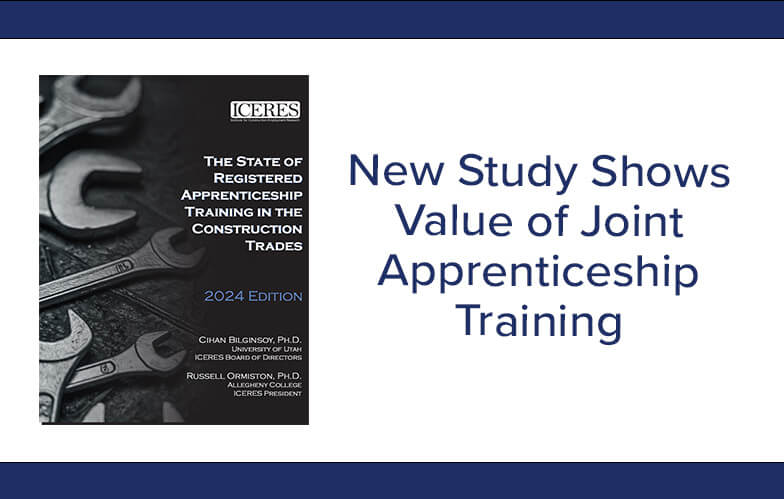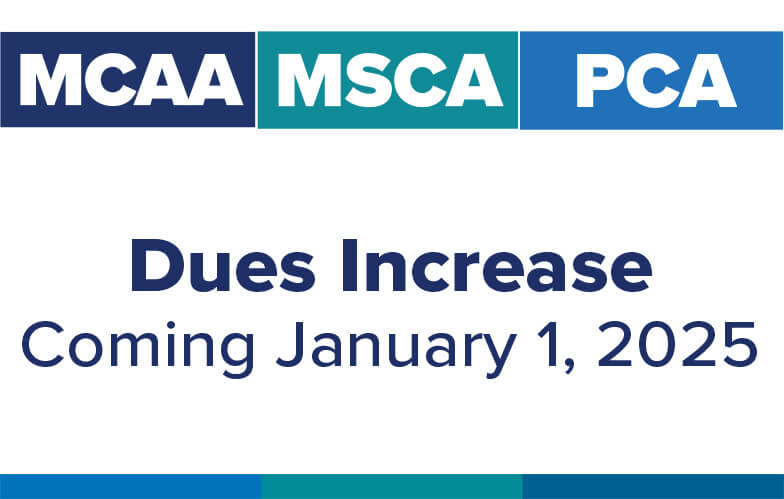
New academic research documents the primacy of the construction industry labor/management joint apprenticeship training infrastructure in building and maintaining the high-skill workforce and employment standards in the construction industry for the benefit of the overall economy, journey workers and apprentices, construction employers, and their public and private sector clients.
The State of Registered Apprenticeship Training in the Construction Industry, 2024 Edition, was recently released by the influential Institute for Construction Employment Research (ICERES) principals, Russell Ormiston, Ph.D, Associate Professor of Business and Economics at Allegheny College, and Cihan Bilginsoy, Ph.D, Emeritus Professor of Economics at the University of Utah. Dr. Ormiston is President of ICERES and Dr. Bilginsoy is a Member of the ICERES Board of Directors. MCAA serves on the ICERES Advisory Board.
Analyzing massive data sets compiled in the U.S. Labor Department’s Registered Apprenticeship Partners Database System (RAPIDS) which includes data from the 24 U.S. Labor Department Registered Programs in 24 states, and data from registered programs in 20 other State Apprenticeship Council (SAC) programs applying Federal standards. (Some states reflect missing or incomplete data in the analysis, and are noted in the methodology section of the report.)
The comprehensive report analyzes jointly administered programs (union sector jointly administered registered programs) as compared with registered non-joint programs (a.k.a. unilateral programs)(most frequently non-union signatory programs) across a broad spectrum of program characteristics, including: registration data; program completion and cancellation rates; demographics of the various programs, including race, gender, ethnicity, veteran status, age, education levels, and on-the-job training credits; and type of program training model (time-based completion standards, competency-based completion regimes, and hybrid time/competency-based programs. The report also details some demographic and economic analysis of the industry overall.
The impartial academic analysis, levels a single basic and very material conclusion derived from the comprehensive analysis, as follows:
“One distinguishing feature of the apprenticeship system in the U.S. construction sector has been the dominance of the programs sponsored jointly by the trade unions and signatory employers. As is documented in this report, the majority of apprentices in the skilled trades train in these jointly-sponsored programs. This means that state and federal policy surrounding collective bargaining or union market share (e.g., prevailing wage laws, support for project labor agreements) can have a substantial impact on the size and capacity of these registered programs.”
Here are some summary excerpts from the 70-pages analysis and report.
Construction Market Trends
- The construction industry added an average of 75,000 new jobs per year between 1973 and 2022.
- The percentage of trades workers age 55 or older has increased over time from 1980 to 2022, rising to 18.4% of the workforce in 2022, and the percentage of workers age 35 and younger has declined over the same period, declining to 36.8% in 2022.
- Plumbers, pipefitters and steamfitters fall in the mid-range in the age 55 or over category among all trades, reaching 18.7% in 2022.
Joint Program Registration As Compared With Non-Joint Program Registration
- 67.7% of all construction apprentices are in registered joint programs, as compared with 32.3% in non-joint programs.
- Among all registrants enrolled in joint and non-joint programs between 2010 and 2016, 76% of all successful completions came from joint programs, as compared with only 24% of all successful completions coming from non-joint programs.
- Women comprised 6.3% of new apprentices in joint programs, as compared with 4.5% in non-joint programs, and completion rates are 14% higher for women apprentices in joint programs as compared with non-joint programs.
- Black apprentices comprised 10% of new program participants in 2021, and Black apprentices comprised 11% of new apprentices in joint programs in 2021, as compared with only 8% in non-joint programs in 2021.
- For participants registered between 2010 and 2016, fully 78.2% of all successful Black apprentice completions came from joint programs, as compared with only 21.8% from non-joint programs over that same period.
Training Program Completion Model
Between 2015 and 2021, 15.6% of apprentices in joint programs were in programs that had a hybrid time-based/competency-based completion model, and 84.4% were in time-based only completion programs, as compared with 3.9% in hybrid model programs in non-joint programs, 1.4% only in competency-based completions, and fully 94.7% in time-based programs in non-joint programs.
Earnings
Among the six largest trades, for apprentices enrolled between 2011 and 2016, average median hourly wages amounted to $34.15 for apprentices upon completion of joint programs, as compared with only $20.70 for graduates of non-joint programs. That spread was even greater for graduates from plumber/pipefitter programs, with joint program graduates earning $35.62, as compared with only $20.00 for graduates of non-joint programs.
Full copies of the report can be obtained from ICERES at https://apprenticebook.com/.
This data may prove most useful in local apprentice program benchmarking, and in local area economic and regulatory and public policy considerations as well. ICERES has plans to update the data periodically, perhaps annually or every other year.




